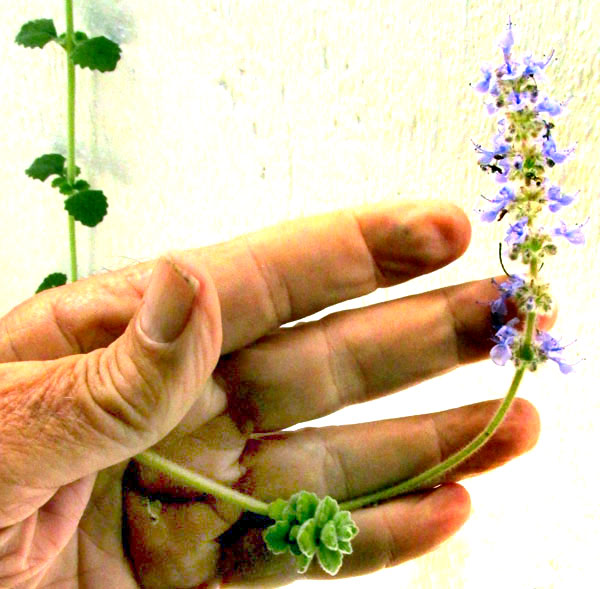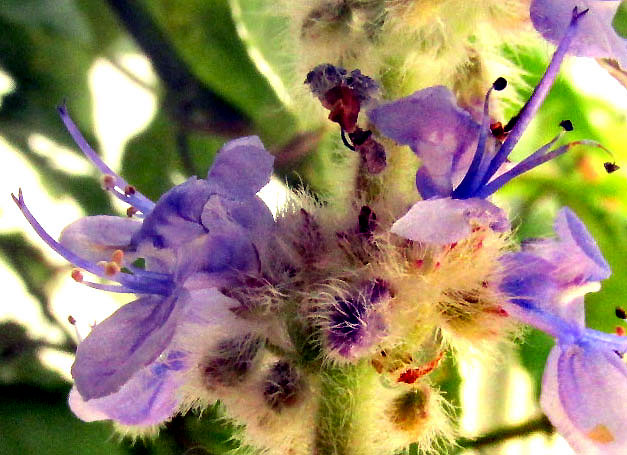Excerpts from Jim Conrad's
Naturalist Newsletter
entry dated December 1, 2022, issued from near Tequisquiapan, elevation about 1,900m (6200 ft), Querétaro state, MÉXICO
VICKS PLANT

In the courtyard of a little village the above plant rooted where two white-stuccoed walls formed an inside corner beneath a family's shady garden alcove covered with a dense canopy of passion-vine. The sprawling, semi-succulent herb, which climbed into the passion-vine's branching stems where it could, finally produced flowers enabling me to identify it. I'd been fairly sure that it was a member of the Mint Family, the Lamiaceae, because its leaves, appearing opposite one another on the stem, were minty in appearance, and when jostled issued a pungent menthol-like odor. However, the Mint Family is a big one, comprising some 236 genera with maybe over 7000 species, and this was a garden ornamental, so it could have come from anyplace in the world.

Its terminal inflorescence of pale blue flowers also was typical of the Mint Family.

The strongly bilaterally symmetrical flowers, each with four stamens, couldn't have been more minty. The calyxes were densely long-hairy, and that hairiness extended to the leaves and stems, which felt soft-fuzzy:

Leaves arose opposite one another, which is normal for the Mint Family. Notice how leafy new sprouts are forming where the petioles connect to the stem. Species in the Mint Family normally develop squared stems, but this plant's stems in certain parts were fairly rounded in cross-sections, while in other parts they were "roundly squared." The plant's most striking feature, however, was its odor.

At the right you see a potted individual of the same species and located right above it, probably the mother of the plant documented above. Its dangling stems were about 2m long (7ft).
Not having taxonomic treatments of cultivated Mint Family species, our plant was identified with an Internet search using various keyword combinations. The words summoning a matching thumbnail picture were "Lamiaceae tropical garden tomentose," Lamiaceae being the Mint Family and the word tomentose meaning "covered with densely matted woolly hairs."
That picture was labeled Plectranthus hadiensis var. tomentosus. However, the authoritative Plants of the World Online website regards that name as one of 30 outdated synonyms of COLEUS HADIENSIS. Having so many synonyms indicates that over the years taxonomists have had a hard time figuring out how this species relates to other members of the Mint Family.
Coleus hadiensis is native mostly to eastern and southern Africa, also to Yemen and Sri Lanka. In the wild, it's found on the fringes of dry forests and in rocky grasslands and lowlands. However, worldwide it's known as an ornamental garden and potted plant, less for its flowers than its evergreen foliage, easy propagation and maintenance, and for its powerfully smelling leaves.
Most English gardening publications call the species Vicks Plant, in honor of the odor of Vicks VapoRub. In Spanish it's something similar, planta de vaporub. At this time most gardening websites still refer to it as Plectranthus hadiensis.
With such an odor, it's not surprising that traditionally the Vicks Plant has found uses in many cultures. It's been used not only to poison fish and as an enema, but to heal wounds , peptic ulcers, diarrhea, diabetes, carcinoma and more. In some places it's used to ward off mosquitoes and evil spirits. Steam off the plant being boiled in water often is reported as clearing the lungs and sinuses. The 2021 review of published works by Saravanan Vivekanandarajah and others entitled "Medicinal values of a horticultural plant - Coleus hadiensis (Forssk.) A. J. Paton" lists research papers finding that our plant's compounds have exhibited antibacterial, anticancer, anti-inflammatory, antimalarial, and antioxidant activity.